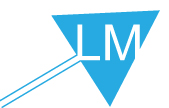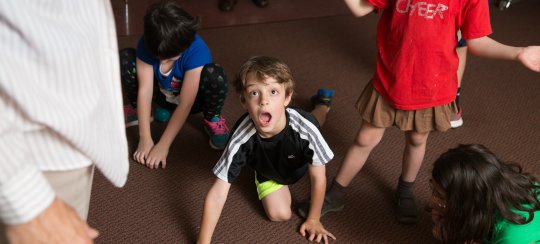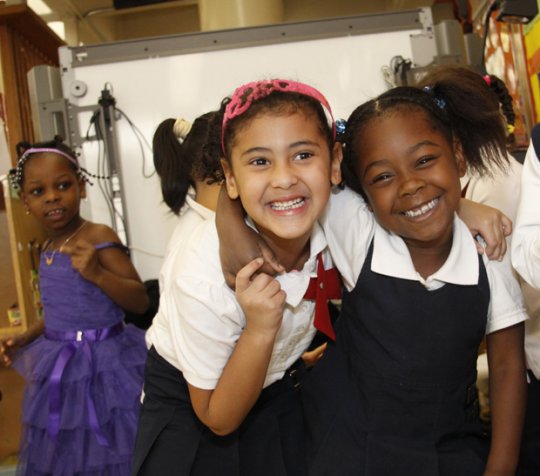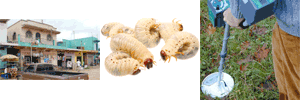Unit 4: Lesson 9
Brainstorm Themes for Seedfolks; Read "Gonzalo" & "Leona;" Investigate & Annotate the Text & Reflect
LITERACY OBJECTIVE
By the end of this lesson students will be able to identify clues in the text that inform the reader about the character and annotate the text to track questions and thoughts while reading.
LITERACY "I CAN" STATEMENT
"I can use my chapter notes and reflection to create a character theme that represents Gonzalo or Leona."
LESSON OVERVIEW
| Steps |
Pacing: 60 Minutes (Varies) |
|
|
15 Minutes |
|
|
45 - 150 minutes |
|
|
|
Standards Alignment
Reading Standards (Literature)
RL 3.1: Ask and answer questions to demonstrate understanding of a text, referring explicitly to the text as the basis for the answers.
RL 3.2: Recount stories, including fables, folktales, and myths from diverse cultures; determine the central message, lesson, or moral and explain how it is conveyed through key details in the text.
RL 3.3: Describe characters in a story (e.g., their traits, motivations, or feelings) and explain how their actions contribute to the sequence of events.
RL 3.5: Refer to parts of stories, dramas, and poems when writing or speaking about a text, using terms such as chapter, scene, and stanza; describe how each successive part builds on earlier sections.
RL 3.7: Explain how specific aspects of a text’s illustrations contribute to what is conveyed by the words in a story (e.g., create mood, emphasize aspects of a character or setting)
RL 4.2: Determine a theme of a story, drama, or poem from details in the text; summarize the text.
RL 4.3: Describe in depth a character, setting, or event in a story or drama, drawing on specific details in the text (e.g., a character’s thoughts, words, or actions).
RL 4.5: Explain major differences between poems, drama, and prose, and refer to the structural elements of poems (e.g., verse, rhythm, meter) and drama (e.g., casts of characters, settings, descriptions, dialogue, stage directions) when writing or speaking about a text.
RL 4.7: Make connections between the text of a story or drama and a visual or oral presentation of the text, identifying where each version reflects specific descriptions and directions in the text.
RL 5.1: Quote accurately from a text when explaining what the text says explicitly and when drawing inferences from the text.
RL 5.2: Determine a theme of a story, drama, or poem from details in the text, including how characters in a story or drama respond to challenges or how the speaker in a poem reflects upon a topic; summarize the text.
RL 5.3: Compare and contrast two or more characters, settings, or events in a story or drama, drawing on specific details in the text (e.g., how characters interact).
RL 5.5: Explain how a series of chapters, scenes, or stanzas fits together to provide the overall structure of a particular story, drama, or poem.
RL 5.7: Analyze how visual and multimedia elements contribute to the meaning, tone, or beauty of a text (e.g., graphic novel, multimedia presentation of fiction, folktale, myth, poem).
Writing & Language
W 4.9a: Apply grade 4 Reading standards to literature (e.g., “Describe in depth a character, setting, or event in a story or drama, drawing on specific details in the text [e.g., a character’s thoughts, words, or actions].”).
W 5.9a: Apply grade 5 Reading standards to literature (e.g., “Compare and contrast two or more characters, settings, or events in a story or a drama, drawing on specific details in the text [e.g., how characters interact]”).
Speaking & Listening
SL 3.1a: Come to discussions prepared, having read or studied required material; explicitly draw on that preparation and other information known about the topic to explore ideas under discussion.
SL 3.1b: Follow agreed-upon rules for discussions (e.g., gaining the floor in respectful ways, listening to others with care, speaking one at a time about the topics and texts under discussion).
SL 3.1c: Ask questions to check understanding of information presented, stay on topic, and link their comments to the remarks of others.
SL 3.1d: Explain their own ideas and understanding in light of the discussion.
SL 3.2: Determine the main ideas and supporting details of a text read aloud or information presented in diverse media and formats, including visually, quantitatively, and orally.
SL 3.3: Ask and answer questions about information from a speaker, offering appropriate elaboration and detail.
SL 3.6: Speak in complete sentences when appropriate to task and situation in order to provide requested detail or clarification.
SL 4.1a: Come to discussions prepared, having read or studied required material; explicitly draw on that preparation and other information known about the topic to explore ideas under discussion.
SL 4.1b: Follow agreed-upon rules for discussions and carry out assigned roles.
SL 4.1c: Pose and respond to specific questions to clarify or follow up on information, and make comments that contribute to the discussion and link to the remarks of others.
SL 4.1d: Review the key ideas expressed and explain their own ideas and understanding in light of the discussion.
SL 4.2: Paraphrase portions of a text read aloud or information presented in diverse media and formats, including visually, quantitatively, and orally.
SL 4.3: Identify the reasons and evidence a speaker provides to support particular points.
SL 4.6: Differentiate between contexts that call for formal English (e.g., presenting ideas) and situations where informal discourse is appropriate (e.g., small-group discussion); use formal English when appropriate to task and situation.
SL 5.1a: Come to discussions prepared, having read or studied required material; explicitly draw on that preparation and other information known about the topic to explore ideas under discussion.
SL 5.1b: Follow agreed-upon rules for discussions and carry out assigned roles.
SL 5.1c: Pose and respond to specific questions by making comments that contribute to the discussion and elaborate on the remarks of others.
SL 5.1d: Review the key ideas expressed and draw conclusions in light of information and knowledge gained from the discussions.
SL 5.2: Summarize a written text read aloud or information presented in diverse media and formats, including visually, quantitatively, and orally.
SL 5.3: Summarize the points a speaker makes and explain how each claim is supported by reasons and evidence.
SL 5.6: Adapt speech to a variety of contexts and tasks, using formal English when appropriate to task and situation.
Writing & Language
W 3.4: With guidance and support from adults, produce writing in which the development and organization are appropriate to task and purpose.
W 3.10: Write routinely over extended time frames (time for research, reflection, and revision) and shorter time frames (a single sitting or a day or two) for a range of discipline-specific tasks, purposes, and audiences.
W 4.4: Produce clear and coherent writing in which the development and organization are appropriate to task, purpose, and audience.
W 4.10: Write routinely over extended time frames (time for research, reflection, and revision) and shorter time frames (a single sitting or a day or two) for a range of discipline-specific tasks, purposes, and audiences.
W 5.4: Produce clear and coherent writing in which the development and organization are appropriate to task, purpose, and audience.
W 5.10: Write routinely over extended time frames (time for research, reflection, and revision) and shorter time frames (a single sitting or a day or two) for a range of discipline-specific tasks, purposes, and audiences.
L 3.1: Demonstrate command of the conventions of standard English grammar and usage when writing or speaking.
L 3.2: Demonstrate command of the conventions of standard English capitalization, punctuation, and spelling when writing.
L 4.1: Demonstrate command of the conventions of standard English grammar and usage when writing or speaking.
L 4.2: Demonstrate command of the conventions of standard English capitalization, punctuation, and spelling when writing.
L 5.1: Demonstrate command of the conventions of standard English grammar and usage when writing or speaking.
L 5.2: Demonstrate command of the conventions of standard English capitalization, punctuation, and spelling when writing.
Teaching Resources
-Music Instruments and Stations
Unit 5 includes the following Life & Learning Skills:
-Reflective thinking
-Creative problem-solving
-Critical and analytic thinking
-Collaboration Communication
 Differentiation Options
Differentiation Options
Differentiation Options will appear throughout the unit to suggest ways to scaffold or challenge student learning. Use the number of helping hands to select the level of differentiation that best supports student learning.


 Highest level of scaffolding. Select this option if students are learning strategies for the first time, if the text is challenging for them, or if students require more guidance during activities. Part 1 lessons are written for the highest level of scaffolding.
Highest level of scaffolding. Select this option if students are learning strategies for the first time, if the text is challenging for them, or if students require more guidance during activities. Part 1 lessons are written for the highest level of scaffolding.

 Moderate scaffolding. Select this option if students require some support comprehending the text or navigating the activity.
Moderate scaffolding. Select this option if students require some support comprehending the text or navigating the activity.

Least amount of scaffolding/Extending the instruction. Select this option if students are ready to work more independently, move more quickly through the material, or are ready for additional challenge.
 Leveraging Moments
Leveraging Moments
Key instructional steps where the arts are used to leverage literacy-learning (and vice versa) are marked with  . Smaller leveraging moments also occur throughout the lessons.
. Smaller leveraging moments also occur throughout the lessons.
Process: Introduce Part 2 and provide students with additional scaffolding as needed for the writing and choreographing of poems.
 Differentiation Options: Reading "Gonzalo" & "Leona"
Differentiation Options: Reading "Gonzalo" & "Leona"
The goal for Part 2 of the unit is for students to read and annotate more independently, with additional scaffolding provided as needed.
Selecting Seedfolks Chapters
Two additional chapters, "Gonzalo" and "Leona," are provided on
pages 11-17 in A4L Texts. See this
brief summary of all Seedfolks chapters. To read additional chapters beyond those provided in the unit material, photocopy selected chapters with space to annotate and take notes in the margins. Assign chapters to Seedfolks Ensembles. Ensembles can read the same or different chapters.


 Guide whole class reading and annotating. Guide ensembles to read, annotate, and reflect on "Gonzalo" and/or "Leona." Walk students through completion of the Seedfolks Character Charts and Reflection Journals for each character.
Guide whole class reading and annotating. Guide ensembles to read, annotate, and reflect on "Gonzalo" and/or "Leona." Walk students through completion of the Seedfolks Character Charts and Reflection Journals for each character.

 Provide moderate scaffolding. Assign half the ensembles to read "Gonzalo" and the other half to read "Leona" and/or additional chapters. Provide groups with scaffolding as necessary. Ensembles complete Seedfolks Character Charts and Reflection Journals.
Provide moderate scaffolding. Assign half the ensembles to read "Gonzalo" and the other half to read "Leona" and/or additional chapters. Provide groups with scaffolding as necessary. Ensembles complete Seedfolks Character Charts and Reflection Journals.
 Ensembles read 2 or more chapters independently.
Ensembles read 2 or more chapters independently. Students read and annotate "Gonzalo," "Leona" (and additional chapters if available) independently. Ensembles work together to complete Seedfolks Character Charts and Reflection Journals.
ELL Support: Comprehensible Input
Support ELL language development and comprehension by starting with a short vocabulary lesson using Vocabulary Snapshots to provide multi-sensory pre-learning for words that may be unfamiliar to culturally diverse students. Click for a
sample lesson plan.
Recommended vocabulary from "Gonzalo" to pre-teach with Vocabulary Snapshots:
- Guatemala - Bodega - Pueblo
- Plaza - Manhole - White Straw Hat
- Trowel - Sprinkling
Recommended vocabulary from "Leona" to pre-teach with Vocabulary Snapshots:
- Goldenrod Tea - Nutmeg - Scrapbook
- Shovels - Metal Detector - Piled High
- Wheelbarrow - Phonebook - Hog Pens
- Maggots - Kitchen Scraps
Sample Visual Icons
Click for Vocabulary Snapshot activities for "Gonzalo" and "Leona" using these visual icons and more (Unit 4 Texts,
pages 27-33 for students and this
resource page for teachers).
Suggested Dialogue
"You're going to take the skills you've gained as reading detectives and musicians and use them to learn about new characters in Seedfolks, create themes, and put them together in a whole class 'Seedfolks Composition' for an invited audience. Let's visit the Unit Overview for Students, so we can see where we are in our process."
Process: Give an overview of the lesson objectives: Brainstorm themes for Seedfolks; assign ensembles additional chapters in Seedfolks; students read, annotate, and reflect on the text.
Suggested Dialogue
"Today we're going to take a step back and think about what we've learned about Seedfolks. Then, we'll read and learn about new characters and work more independently to annotate and complete the character chart."
"By the end of today's lesson, you will be able to say, 'I can identify clues in the story that tell me about the character and make notes about the things I am thinking while I read; I can identify a theme for Seedfolks'."
Process: Guide students to brainstorm possible central themes for Seedfolks by reviewing their Reflection Journals and looking for similar threads between Kim, Ana, and Wendell. Students record brainstorms in their A4L Notebooks on
page 29, Seedfolks Central Theme.
There are multiple themes that are appropriate for Seedfolks.
Connecting Literacy & Art
Theme: Literacy & Music Connections
In this unit, "theme" is used both as a literacy and a music term, representing the big ideas that tie a piece of music or a story together.
In a story, a theme is a big idea, or one of several, that give the story its meaning. In music, a theme is a musical idea that is important to the structure of the composition. These concepts come together in the final Seedfolks Composition.
Theme is used three ways:
Central Story Theme: This term is used for the "big idea" the class selects as the main theme of the story.
Character Theme: This term is used for the piece of music students create for each character. Each chapter is a character vignette and thus operates as a mini-story with its own big idea(s). By tracking the themes of the character vignettes, students will be able to identify big ideas that span across the entire story.
Seedfolks Theme: This term is used for the main musical theme composed for the final Seedfolks Composition. The Seedfolks Theme is a musical interpretation of the Central Story Theme.
Suggested Dialogue
Brainstorming Several Possible Themes for Seedfolks
"We've read the first three chapters of Seedfolks and met the first three characters: Kim, Ana and Wendell. Before we continue reading, let's stop and think about what brings all these characters together. Is there something we can say about all three of them--something that ties them together?"
"Let's go back to our A4L Notebooks and look over our 'Big Idea' statements for Kim, Ana, and Wendell. What did each character learn about him or herself, or another person? Take a few minutes and read over your journal entries on pages 6, 9, and 15. (Students review their Reflection Journals.) Pair-share with a partner anything you noticed that ties these characters together. (Students pair-share.) Let share out. I'll record your ideas on the board." (Students may respond "they are lonely," "they all do something in the garden," "they all feel hopeful at the end of their chapters," or "they all notice each other." Record.)
"We're going to take these ideas and brainstorm several possible themes for Seedfolks. In books, themes are the ideas and lessons that give the story its meaning. For example, a possible theme for this book might be, "Common space brings people together." (Feel free to give an example from another familiar story.) For a rich book like Seedfolks, there is not one right theme - we might come up with several themes that all work and represent different things we are learning."
"Now, let's take these ideas and try out several theme statements. Turn to the Seedfolks Central Themes page in your A4L Notebook (page 29). We'll begin our statement with "The central theme of Seedfolks is. . ." Spend a few minutes on your own thinking, and maybe writing some ideas down. Look at the list on the board to help you. (Students think and write.) Pair-share with a partner your thoughts and ideas, and together write at least one theme statement. (Students pair-share and write.) Let's share out and record all our central theme statements in our A4L Notebooks. (Students share and record theme statements. Potential central themes include:"
-One person's hope can affect others.
-Common space brings people together.
-A community can be built out of nothing.
-People can change with the help of others.
-Community is built around a common goal or interest.
-People look out for each other if they have something in common.
-People can learn to appreciate each other's uniqueness when creating something together, whether it is a garden or a piece of music.)
"In just a moment, you are going to work with your ensemble to read another chapter in Seedfolks. After we read and learn about more characters, we'll come back to these central theme statements, and choose the one we think best fits the book, or write a new theme statement."
Process: Guide students to sit in Seedfolks Ensembles with their A4L Texts & Notebooks. Tell students to wait for the "Go" signal to begin moving. Assign "Gonzalo" and/or "Leona" to ensembles. Half the class can read each chapter or all ensembles can read both chapters. See this
resource page for a brief summary of each chapter and this menu
Differentiation Options: Reading Additional Chapters in Seedfolks (top of this lesson) to aid in decision-making.
"Gonzalo" and "Leona" are on pages 11-17 in students' Unit 4 Texts.
Suggested Dialogue
Instructions for the Step
"When I play the 'Go' signal, take your A4L Texts, Notebooks, and a pen or pencil and move to sit with your Seedfolks Ensembles." (Play "Go" signal.)
"Now, I will give each ensemble a new chapter to read." (Assign new Seedfolks chapters to ensembles.)
Process: Ensembles work independently or with appropriate scaffolding to read and annotate their new Seedfolks chapter. Explain the process to students: at each stopping point, readers should stop and annotate the text by asking "I wonder" questions; looking for clues that tell the reader what the character is thinking, feeling, or doing; and making notes in the margins. See this reference document,
Reading Like A Detective.
Suggested Dialogue
"Today you will work more independently to read like detectives and annotate your text. Let's review: how do we read like detectives?" (Students respond "ask questions," "look for clues about what the character is thinking, feeling, and doing," and "write ideas in the text.")
"To start, everyone will read the first excerpt in the chapter. Then you will stop and record "I wonder" questions, circle clues, look for connections to other characters, and write your ideas in the margins. Before reading again, talk with your group about your investigations. Then continue reading and annotating the next excerpt. Decide whether you want to fill in your Seedfolks Character Chart as you read or after you are finished reading." (Students read, annotate, and discuss. Circulate to support students as needed.)
Process: Ensembles independently complete the Seedfolks Character Chart for their new character(s). Students get their A4L Notebooks and turn to
page 18.
Suggested Dialogue
Ensembles independently complete the Seedfolks Character Chart
"Open your A4L Notebooks to page 18. You will now reflect on what you've learned about your character. In the "Character" column, write the name of your character and draw a picture of him or her in the box." (Students write and draw.)
"Together with your ensemble, work through the next three columns. Record basic facts about your character and what he or she did in the garden. Use your annotations to reflect on what your character is like and if he or she changes throughout the chapter. Finally, talk together about the sounds you can use to represent his or her feelings and transformation." (Ensembles discuss and record. Circulate to support students.)
Process: Guide ensembles to gather instruments. Depending on how the room is set up, invite two to four ensembles at a time to gather instruments. Ensembles should gather at least one from each music station. Rotate the order in which groups collect instruments each day.
Suggested Dialogue
"Now that we've done some great reading detective work, we're going to use music to help us think more deeply about the characters. This brings us one step closer to creating an entire musical soundtrack with character themes and a central story theme for our final Seedfolks performance!"
"Today, Ensembles (designate) will gather their instruments first. Tomorrow, the other Ensembles will go first. When I play the "Go" signal, Ensembles that I called, please go to the music stations and gather enough instruments for everyone at your table. Be sure to get an instrument from each station. You have two minutes." (Play "Go" signal. First set of ensembles gathers instruments. Repeat process for remaining ensembles.)
 Process:
Process: Guide ensembles to use their instruments to try out several of the sounds they brainstormed for either Gonzalo or Leona. Ensembles should select 3-4 characteristics or feelings and their corresponding sounds to try out using instruments. After 5-7 minutes of experimentation, invite students to demonstrate their sounds for the class.
Total time for practicing and demonstrating sounds is 12 minutes.
Suggested Dialogue
"Now that you have selected your instruments, you get to try out several of the sounds you brainstormed for Gonzalo or Leona."
"Use the notes you wrote on your Seedfolks Character Chart. Before you begin playing, talk together as an Ensemble and circle or star 3-4 character traits, feelings or changes that you want to represent through music." (Ensembles select character traits, feelings or changes.)
Guide students to practice creating sounds to represent the character.
"Taking turns, create sounds on your instruments to represent your character's feelings, traits, or changes."
"At the 'Go' signal, you have 5-7 minutes. (Play "Go" signal. Students create sounds. After 5-7 minutes, play 'Freeze' signal.) At rest." (Students put instruments down.)
Invite students to share sounds.
Process: Students work independently to reflect on their character.
Suggested Dialogue
Using the Reflection Journal
"Turn to the Reflection Journal on page 20 in your A4L Notebooks. Use this space to write your personal thoughts and reflections on your character."
"You can write about anything that stood out for you. Here are some questions to get you started. You don't have to answer every question.
-What have you learned from the character?
-What do you think is the most important thing to remember about the character?
-Did this character, or something that happened in the chapter, make you think of an experience in your own life?"
"Pair-share with a partner a thought you have about one or more of these questions and then spend a few minutes writing." (Students pair-share and write in journals.)
"What big ideas are you left thinking about? You might have written about something in the space above that you think is important in this chapter. It can be a single word or a phrase. There is not a right answer. (Students respond.) Take a minute to write your ideas." (Students write in journals.)
Process: To give students more practice reading, annotating, and reflecting independently or with ensembles, assign additional Seedfolks chapters.
Step Alternatives: Optional Writing Extension
Writing a new Chapter in Seedfolks:
Incorporate the unit into your writing program by having students write their own chapter in Seedfolks.
Have students:
1. Introduce themselves & their family: Who are you? How did you get to this neighborhood?
2. Describe a real problem that they are facing and how could the garden help them solve or deal with that problem.
3. Describe how they are changed by the garden and how any of the other characters helped.
Process: Close the lesson with a look forward, describing the next lesson.
Suggested Dialogue
"In our next lesson, you will take your investigations and the music you created for your character, and put together a theme."
Performing The Closing Ritual (Optional)
"To close our theater lessons, we'll appreciate our work and each other with a unified clap. On three we'll all clap once and say, 'Huh!' 1-2-3 (clap) Huh!"
CONGRATULATIONS ON COMPLETING LESSON 9! YOU ARE NOW READY TO MOVE ONTO LESSON 10 OF UNIT 4.

 Differentiation Options
Differentiation Options ![]() Leveraging Moments
Leveraging Moments Differentiation Options: Reading "Gonzalo" & "Leona"
Differentiation Options: Reading "Gonzalo" & "Leona"



